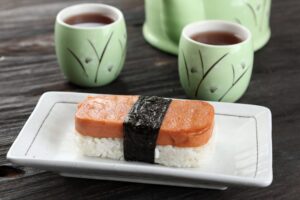The History of Spam: From Wartime Rations to Global Delicacy
The History of Spam: From Wartime Staple to Global Culinary Icon

Spam, the iconic canned meat, has had an unexpected journey from wartime necessity to beloved food staple across the world. While some see it as a quirky throwback, Spam’s rich history reveals a versatile product with a profound impact on food culture in many regions.
This blog explores Spam’s origins, its crucial role during World War II, and its enduring presence in contemporary cuisines around the globe.
The Birth of Spam: A Solution to Modern Food Needs
Spam was introduced in 1937 by Hormel Foods, a Minnesota-based company aiming to create an affordable and shelf-stable meat product. Its simple recipe—pork, ham, salt, water, potato starch, and sodium nitrite—was designed to last without refrigeration while retaining a distinctive flavour. The name “Spam” is thought to be a contraction of “spiced ham,” though its exact origin remains a bit of a mystery.
Spam was born into an era when convenience foods were becoming increasingly popular, but it was World War II that propelled the product to international fame, forever cementing its place in history.

Spam During World War II: A Lifeline on the Front Lines
When World War II erupted, Spam’s shelf-stability and portability made it a vital food source for Allied troops. Over 100 million pounds of Spam were shipped abroad to feed soldiers, and it became a staple in military rations. Soldiers often joked about Spam, calling it “ham that didn’t pass its physical,” but they also relied on it for sustenance. British Prime Minister Margaret Thatcher even referred to it as a “wartime delicacy.”
Beyond the battlefield, Spam played a crucial role in feeding populations affected by food shortages. In the United Kingdom, where rationing was in effect, Spam became a dietary staple, providing a much-needed source of protein. American soldiers shared their Spam rations with local communities across Europe and Asia, introducing the product to new audiences who embraced it out of necessity.
Post-War Spam: From Survival Food to Culinary Innovation
After the war, Spam’s popularity didn’t wane; in fact, it became a household name in many of the regions it had reached during wartime. In the United States, its convenience and affordability made it a pantry staple.
Hormel took advantage of its popularity by launching marketing campaigns showcasing Spam’s versatility in recipes like Spam casseroles, sandwiches, and even Spam and eggs for breakfast.
In the UK, Spam continued to be a popular ingredient in dishes like Spam fritters, where battered slices of Spam are deep-fried for a tasty treat. It became a comfort food for many who remembered it as part of their wartime diet.

Spam’s Global Appeal: A Cultural and Culinary Icon
Spam’s adaptability has made it a culinary mainstay in several countries, where it has taken on cultural significance and been integrated into traditional dishes. Here’s a closer look at how different regions have embraced Spam in unique ways:
- Hawaii: Spam is perhaps more beloved in Hawaii than anywhere else. Introduced to the islands by American troops during World War II, Spam quickly became a local favourite due to its affordability and long shelf life. Today, Hawaii consumes more Spam per capita than any other U.S. state, and Spam musubi—a sushi-like snack of grilled Spam on top of rice, wrapped in seaweed—is a popular item found in convenience stores and restaurants. Hawaii even hosts the annual Spam Jam festival, where creative Spam-based dishes are celebrated.
- South Korea: Spam arrived in South Korea during the Korean War and initially carried a certain prestige as it was seen as a rare Western delicacy. Over time, Spam became part of Korean cuisine, often given as a gift during holidays like Chuseok (Korean Thanksgiving). One of the country’s most popular dishes featuring Spam is budae jjigae, or “army stew,” a spicy hotpot that mixes Spam with ingredients such as kimchi, instant noodles, and tofu—a nod to its origins in post-war food scarcity.
- The Philippines: Introduced during World War II, Spam remains popular in the Philippines, where it is often enjoyed fried with garlic rice and a fried egg for a breakfast dish known as “Spam silog.” Its versatility means it also appears in sandwiches, pasta, and local favourites, serving as a beloved reminder of shared history.
- United Kingdom: In the UK, Spam gained popularity during rationing and maintained its presence in British cuisine long after the war. Spam fritters became a traditional dish, where slices of Spam are battered and fried. For many, these fritters are a nostalgic comfort food that harkens back to simpler times.

Pop Culture and Spam’s Quirky Legacy
Spam’s ubiquity has also given it a place in pop culture. The most famous example is the Monty Python “Spam” sketch from 1970, which humorously depicted a restaurant where every dish contained Spam, poking fun at its widespread use. This sketch is credited with popularising the term “spam” to describe unwanted digital communication, cementing Spam’s cultural significance in both culinary and linguistic terms.

Modern-Day Spam: A Revival of Nostalgia and New Uses
Spam has seen a resurgence in recent years, driven by trends in comfort food, nostalgic cooking, and an increased appreciation for canned goods during crises like the COVID-19 pandemic. Many chefs have embraced Spam’s unique flavour and texture, incorporating it into gourmet dishes and fusion cuisine. It is no longer just a wartime staple but a versatile ingredient that continues to inspire creativity in kitchens worldwide.

From Necessity to Culinary Innovation
Spam’s journey from a wartime ration to a global culinary icon is a testament to its resilience and adaptability. Whether it’s served up as a Hawaiian musubi, a Korean army stew, or a classic British fritter, Spam continues to surprise and delight those who appreciate its unique history and versatile nature. What began as a practical solution during difficult times has evolved into a beloved food that spans cultures and generations.
In the end, Spam’s story is not just about a can of meat, but about the people who found ways to turn necessity into culinary creativity, making Spam a lasting symbol of resilience and adaptability.